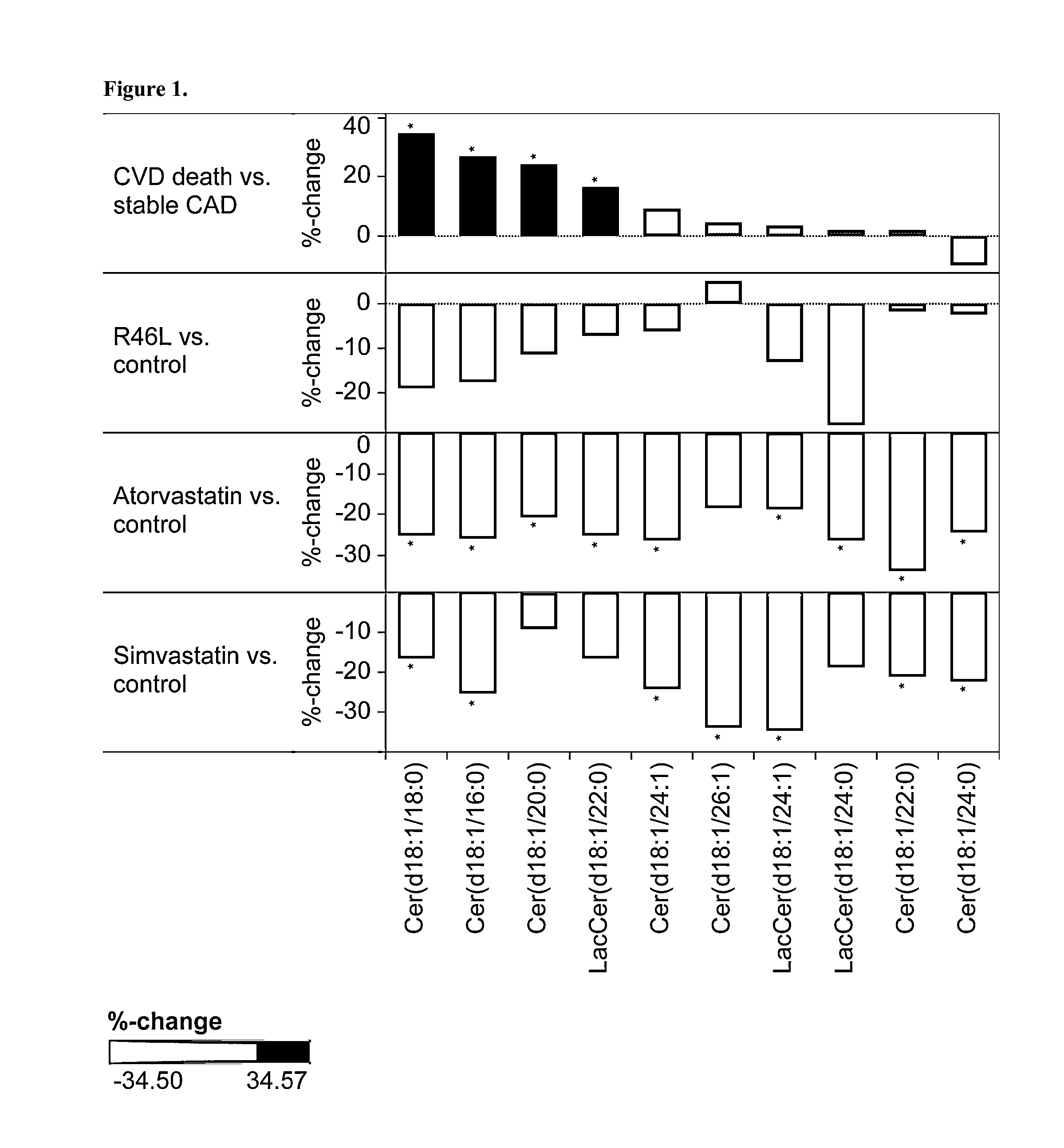Sensitive Efficacy and Specificity Biomarkers for Proprotein Convertase Subtilisin/Kexin Type 9 (PCSK9) Inhibition
a proprotein convertase and inhibitory technology, applied in the field of sensitive efficacy and specificity biomarkers for proprotein convertase subtilisin/kexin type 9 (pcsk9) inhibition, can solve the problems of unwanted side effects and harmful effects on patients, and achieve the highest precision in liquid handling, isolation and purification, and minimize potential errors
- Summary
- Abstract
- Description
- Claims
- Application Information
AI Technical Summary
Benefits of technology
Problems solved by technology
Method used
Image
Examples
example 1
Materials and Methods
[0161]Plasma samples from wild-type (Wt), PCSK9 homozygote knock-out (Pcsk9− / −), and PCSK9 heterozygote knock-out (Pcsk9+ / −) animals were used for lipidomic analyses. Each group had 18 male mice aged 3 months. Up to 3 months' age the mice were on the same regular chow diet (day 0). Thereafter, mice were first on regular chow-diet (2018 Teklad Global, Harlan Laboratories) for two weeks after which 3 mice from each group were sacrificed for tissue sampling (day 15). The remaining mice were switched to standard Western diet (TD.88137 Harlan Teklad) for a period of two weeks after which all remaining mice were sacrificed (day 30). The Western diet contained 34%, 21%, and 0.2% of sugar, fat, and cholesterol, respectively, whereas the regular chow diet contained 5%, 6%, and 0% of these ingredients, respectively.
[0162]Mice were kept fasted for 4 h before bleeding. Cheek bleeds of about 250 μl were drawn using the 500 μl microcontainers (BD) containing EDTA. The blood s...
example 2
Materials and Methods
[0164]This study is a sub-cohort of the LURIC study that is a large scale prospective study on cardiovascular epidemiology. LURIC database contains clinical information over 3000 patients including baseline coronary angiography and routine clinical laboratory data. In this study, the inventors compared lipidomic profile in subjects carrying a know loss-of-function mutation (R46L, rs11591147, Abifadel, M. et al. 2003. Mutations in PCSK9 cause autosomal dominant hypercholesterolemia. Nat Genet 34: 154-156) with the lipidomic profile in subjects carrying the major allele with normal PCSK9 function. This comparison allowed inventors to determine a typical lipidomic profile induced by PCSK9 partial deficiency. The clinical characteristics are described in Table 1.
TABLE 1Background characteristics for LURIC patients analyzed with lipidomicsVariableControls (n = 541)Cases (n = 12)Age (average)65.166.3LDL-C (mg / dL)116.8108.3HDL-C (mg / dL)36.838.2Lipid lowering users2482
[...
PUM
| Property | Measurement | Unit |
|---|---|---|
| length | aaaaa | aaaaa |
| temperature | aaaaa | aaaaa |
| molecular weight | aaaaa | aaaaa |
Abstract
Description
Claims
Application Information
 Login to View More
Login to View More - R&D
- Intellectual Property
- Life Sciences
- Materials
- Tech Scout
- Unparalleled Data Quality
- Higher Quality Content
- 60% Fewer Hallucinations
Browse by: Latest US Patents, China's latest patents, Technical Efficacy Thesaurus, Application Domain, Technology Topic, Popular Technical Reports.
© 2025 PatSnap. All rights reserved.Legal|Privacy policy|Modern Slavery Act Transparency Statement|Sitemap|About US| Contact US: help@patsnap.com



